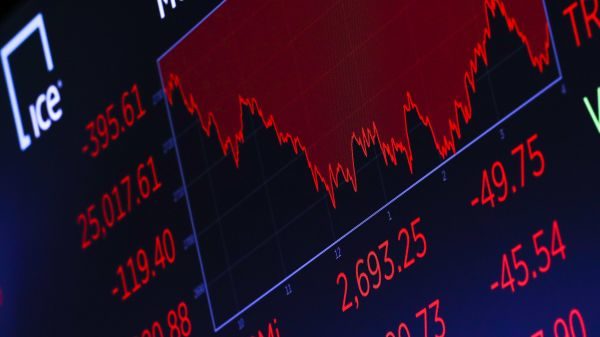The world economy today is worse prepared to cope with a recession than in 2008
Per-Åke Westerlund
What awaits the world economy in 2019? Capitalists and speculators around the world hold their breath after stock markets recorded their worst December result since 1931.
Christmas Eve was the weakest trading session in New York of the whole year, while Boxing Day showed the biggest rise in a day ever. For the whole of 2018 global stock markets fell by 12 percent, according to the FTSE All-World Index. The largest decline, more than 20 percent on average, was in the so-called “emerging markets”, i.e. outside of Europe and North America. The Chinese stock markets in Shanghai and Shenzhen fell by 25 and 33 percent.
But it’s not just stock markets that cause concern. Growth will slow, especially in key countries like the US, China, Japan and Germany.
And it is not the capitalists who are affected in the first place, although their fortunes on paper have already shrunk by hundreds of billions of dollars. The price of every stock market fall is paid by workers and the poor around the world, with unemployment, salary cuts and new austerity measures.

Forecasts wrong
2018 ended in a totally different way to economists’ forecasts at the beginning of the year. A year ago there was talk of a new general global economic upturn, the largest since the crisis hit in 2008-09. Optimism was growing, especially as Trump’s policies both cut taxes and boosted stock prices.
The weak recovery since 2009 has been based on increased debt, not least the extreme stimulus from central banks. The European Central Bank, the ECB, alone bought government bonds (individual state debts) of over 2.15 trillion euro in just over three years, from 2015 to 2018.
America’s central bank, the Federal Reserve, invested over 3.5 trillion dollars in corresponding purchases 2008-2015. Central banks also lowered interest rates to record low levels, or even minus in the case of the ECB, Sweden and other countries.
During 2018 there was a growing realization that this could not continue. The stimulus was brought to an end or slowed down and the Fed began in late 2015 to raise interest rates.
A crucial factor since 2009 has been China’s growing mountain of debt. From the end of 2008 to the first quarter of 2018 the country’s gross debt rose from 171 percent of GDP to 299 percent (according to the Institute for International Finance). Even the Chinese government has tried to slow the growth of debt. Overall, global debt is now three times larger than 20 years ago.
The factors that led the recovery – which was weak, creating even greater gaps – are now acting to hold it back. Higher interest rates are hitting businesses, households, municipalities and states that have the largest debts.
Concerns over the Christmas and New Year period were reinforced by reports that US Treasury Secretary Steven Mnuchin ordered an examination of the state of the country’s banks, and Apple warned of a sharp drop in sales especially in China.
The figures for the third quarter of last year, the latest to be reported, confirmed these concerns. In Germany, Japan and Italy economies shrank from July to September. If the trend continues into another quarter these countries are officially in recession. In December, France had also negative numbers.
In the euro zone as a whole, growth was only 0.2 percent. Growth in China – 6.5 percent during the third quarter of 2018 – was the lowest in 10 years. Even the US is slowing, and the forecast for 2019 is just 2.5 percent. The worst crisis countries, such as Turkey and Argentina, are hit even harder.
Global tightening
These trends prompted Trump to launch a sharp attack on the Fed for its rate hikes, which according to the president are the “only problem” in the US economy. Trump and many economists predict that rising interest rates will increase the value of the dollar and lead to global tightening, especially in the “emerging markets” with capital flooding out to the US in search of higher returns.
Trump’s attacks have clearly influenced Fed Chairman Jay Powell, who said earlier that reduced stimulus and higher interest rates were set on “autopilot” but has now signaled a slower pace.
In addition we have Trump’s nationalism and trade wars. His focus on China has so far received strong support from politicians and capitalists in the US, where the issue is not viewed only in economic terms, but is also a global power struggle between the two imperialist states.
As we pointed out the “agreement” between Trump and Xi Jinping in Buenos Aires in December, doesn’t mean the trade war is over. Without a new agreement, Trump has promised to raise tariffs from 10 percent to 25 percent on 200 billion dollars worth of Chinese goods. The Chinese regime is showing a willingness to backtrack slightly, after initially underestimating the threat from Trump, but there are political limits to how far it can go.
Trump has also introduced steel and aluminum tariffs, plus the threat of tariffs on motor vehicles. The latter would, according to the IMF, reduce world growth by 0.75 percent. World trade has already been reduced as a result of the trade war.
Rising discontent – build the socialist alternative
All these factors have got an increasing number of capitalist economists to warn of a new crisis. The Economist magazine’s supplement on the world economy last autumn was only about the “next downturn”. Nouriel Roubini, the economist who warned before the crash of 2008, predicts a new crisis in 2020.
Most of these predictions say that the world economy today is worse prepared than in 2008. The measures used then have now already been used: record low interest rates, higher debt, stimulus.
“We are less prepared to cope with the recession than we should be – and less prepared than in the last crisis in 2008,” said David Lipton, deputy director of the International Monetary Fund in an interview with the Financial Times.
A big difference with 2008-09, is also the growing nationalism and protectionism from the various national capitalist classes and governments. The crisis must be paid by the workers and the poor, in their own country and in competing countries – this is the logic of capitalism.
For the left, the socialists and the labour movement globally this underlines the urgent need for a real alternative. Capitalism today only offers new crises – economic, social and ecological. There is growing discontent, which in 2018 led to increased workers’ struggles in the US and new movements, like the “yellow vests” in France. What is needed is a massive organised struggle for a different system – democratic socialism, where the economy is planned for the needs of humanity and the environment.




